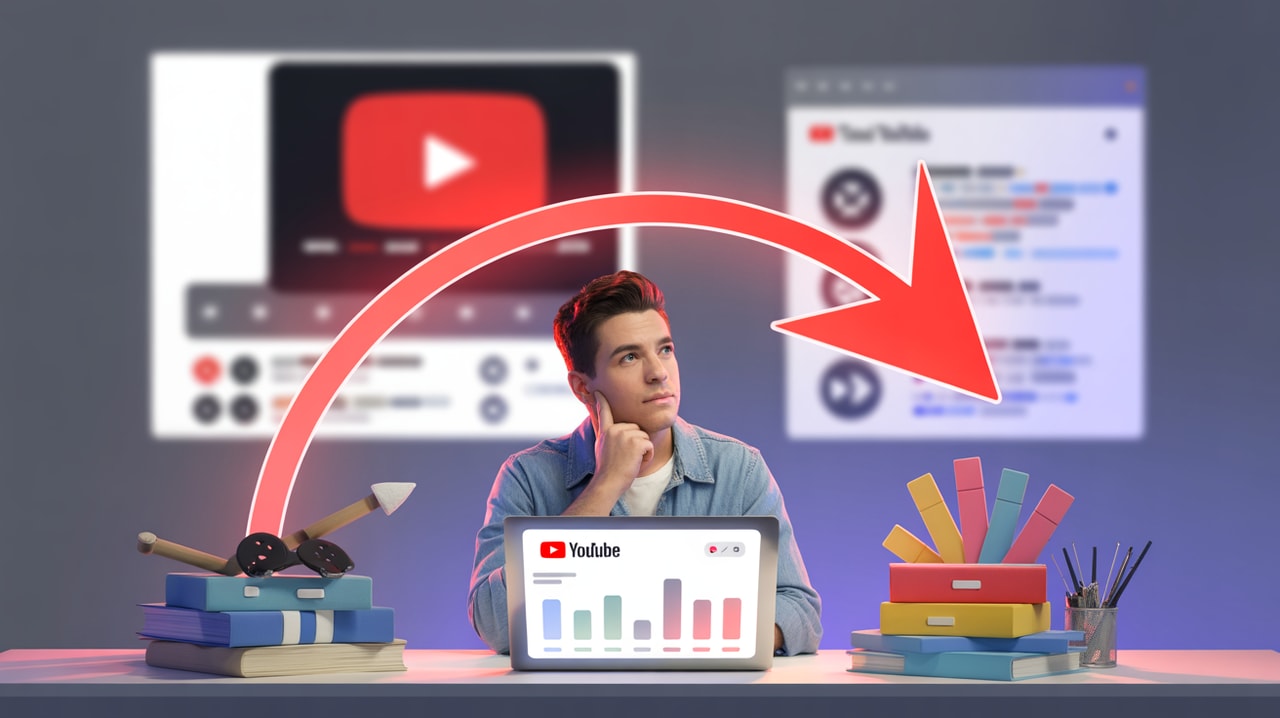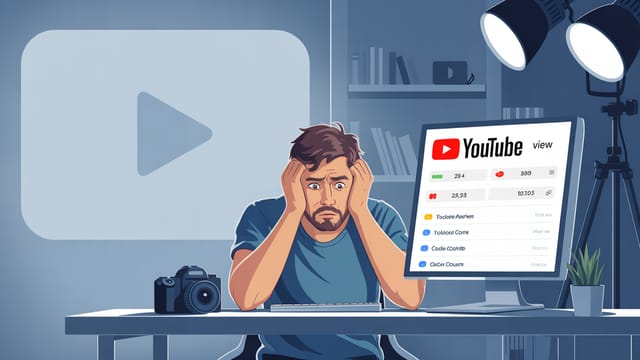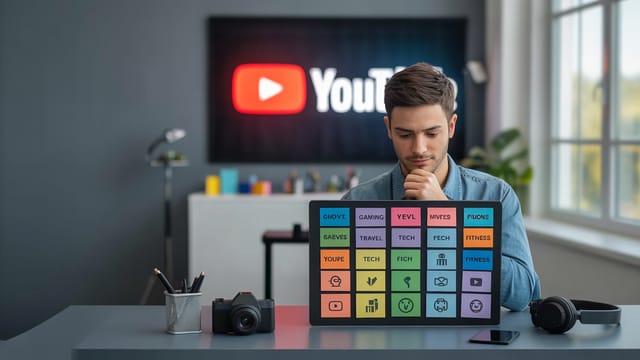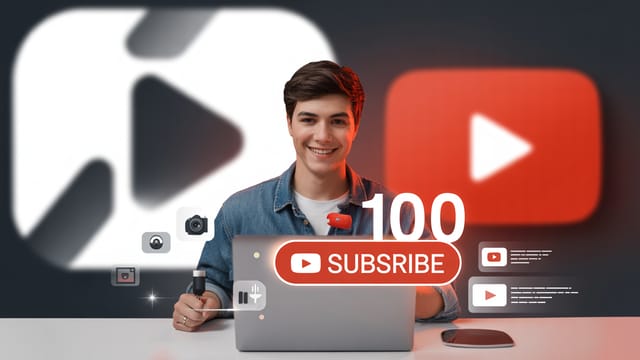
Ready to get your next 10,000 subscribers?
Join thousands of creators who use Subscribr to create faster, better YouTube videos.
Okay, here is the article based on the research and requirements.
Feeling stuck on YouTube? Maybe your initial passion has faded, the niche isn't performing as expected, or a new opportunity has emerged. Whatever the reason, you're considering changing direction – a YouTube niche pivot.
It's a daunting thought. Will you lose your existing audience? How do you even begin to transition? This guide is for advanced creators and strategists ready to tackle the art of the pivot, minimizing subscriber loss and strategically positioning your channel for future growth and monetization.
Pivoting isn't just about changing topics; it's a strategic evolution of your content, audience, and brand. A successful pivot can breathe new life into a stagnant channel, align your content with evolving passions or market opportunities, and unlock new avenues for monetization.
Is It Time to Pivot Your YouTube Niche?
Knowing when to pivot is often the hardest part. It requires honest self-assessment and a data-driven understanding of your channel's performance and audience.
It's easy to mistake a temporary creative block or a few underperforming videos for a sign you need to change everything. Before you make a drastic move, ask yourself:
- Is your passion gone? If you dread creating content in your current niche, burnout is inevitable. Authenticity resonates on YouTube, and if you're no longer genuinely interested, your audience will eventually notice.
- Is the niche performing below expectations despite consistent effort? You've been consistent, focused on quality, and analyzing your data, but growth is stagnant or declining. This could indicate the niche is too small, too saturated, or simply not a good fit for your skills and style.
- Have your long-term goals changed? Your channel's initial purpose might no longer align with your personal or business aspirations. A pivot could be necessary to create content that serves your evolving vision.
- Is a new, more promising opportunity calling? You might discover a related niche with higher demand, less competition, or better monetization potential that genuinely excites you.
Crucially, distinguish a genuine need to pivot from chasing a "shiny new object." Sometimes, consistent effort right before a breakthrough can feel like hitting a wall. Analyze your data using tools like Subscribr's Channel Intelligence to understand trends, velocity scores, and outlier videos. Are there any patterns in your current content that suggest a slight adjustment could yield better results, rather than a full pivot?
If, after careful consideration, you're convinced a pivot aligns with a deeper, long-term conviction, then it's time to plan the transition.
Strategic Content Planning for a Pivot
A successful pivot isn't impulsive; it's a carefully planned strategic maneuver. It involves researching the new direction, understanding your potential new audience, and determining how to bridge the gap from where you are now.
1. Identify and Validate the New Niche:
Just like choosing your first niche, the new niche needs to be "Proven and Profitable," as often discussed in YouTube strategy circles.
- Proven: Are there other channels succeeding in this space? Analyze successful channels in potential new niches using tools like Subscribr's Channel Intelligence. Look at their subscriber counts, view counts, and growth patterns. What kind of content performs well?
- Profitable: How can you monetize this niche? Consider ad revenue (CPM), affiliate marketing, selling your own products/services, sponsorships, etc. Does the audience in this niche have purchasing power or interest in related products/services?
Use Subscribr's Research Assistant to gather information on the new niche, potential topics, and audience demographics. This is where you build the foundation for your new content strategy.
2. Find the Overlap (or lack thereof):
Is there any overlap between your current audience and the potential new audience? If you're moving from sewing tutorials to coaching people who sew, there's significant overlap. If you're moving from gaming to finance, the overlap is minimal.
- High Overlap: A gradual transition on your existing channel is more feasible.
- Low Overlap: You risk confusing your existing subscribers, which can negatively impact performance metrics like click-through rate and audience retention on your new content. In this case, starting a new channel might be the more strategic move, especially if your old channel still generates passive income or views. As YouTube strategists often advise, sometimes it's better to start fresh and apply everything you've learned from your first channel.
Niche Refinement & Positioning During the Transition
Once you've decided on the new niche and whether to use your existing channel, the next step is positioning your content for the transition.
1. Gradual Integration (for channels with overlap):
If there's overlap, subtly introduce elements of the new topic into your existing content. If you're moving from sewing tutorials to sewing business coaching, mention your coaching services or share insights relevant to business growth within a tutorial video. This "seeds" the new content and helps your audience become familiar with the direction you're heading.
2. Create Explainer Content:
Regardless of overlap, dedicated videos explaining the pivot are crucial. Be transparent with your audience. Explain why you're making the change, what the new content will be about, and what they can expect. Address their potential concerns directly. While these videos may not get the most views, they are vital for maintaining a connection with your core audience and inviting them on the new journey.
3. Align New Content with Audience Pain Points:
Frame your new content as a solution to problems your audience faces, even the audience you hope to attract in the new niche. Use audience research (which you can do with Subscribr's tools by analyzing successful channels in the new niche) to understand their needs and tailor your messaging.
4. Update Your Branding:
Your channel banner, profile picture, and video thumbnails should start reflecting the new niche. This visual cue helps new viewers understand your content immediately and signals the change to existing subscribers. Consistency in your new visual identity is key.
Audience-Centric Content Development for the New Niche
As you develop content for your new niche, keep your target audience at the forefront.
1. Deep Dive into New Audience Research:
Who is the ideal viewer for your new niche? What are their interests, problems, and content consumption habits? Use Subscribr's Research Assistant to analyze popular videos and channels in this new space. Look at comment sections to understand audience questions and pain points. This data is invaluable for generating relevant video ideas and tailoring your content to resonate.
2. Develop a New Content Strategy:
Based on your research, plan your video formats, topics, and upload schedule for the new niche. Will you create tutorials, documentaries, reviews, vlogs, or a mix? Use Subscribr's Script Building Pipeline to structure your ideas, conduct research, and draft scripts that are optimized for audience engagement and retention – the real drivers of success on today's YouTube.
3. Focus on High-Retention Content:
YouTube's algorithm prioritizes watch time and audience retention. Regardless of your niche, focus on creating engaging content that keeps viewers watching. Use strong hooks (which Subscribr's tools can help you craft), clear pacing, and compelling storytelling.
Will I Lose Subscribers When I Pivot?
The honest answer is: probably some. This is a reality of changing direction. Subscribers initially joined for your old content, and not all of them will be interested in the new topic.
This is okay.
The goal of a pivot isn't to keep every single subscriber from your old niche. The goal is to attract a new audience interested in your new content while retaining as many of your core fans as possible who are willing to follow you.
Focus on creating high-quality content in the new niche that attracts new viewers. As you gain traction in the new area, the growth from that audience will eventually outweigh any initial subscriber loss. Be patient; building a new audience takes time and consistent effort.
If you have a large, established channel in the old niche that still performs well, starting a separate channel for the new niche might be the safer option to avoid alienating your existing audience and potentially harming the performance of your old, still-valuable content.
The Best Way to Transition to a New Niche
Combining the strategies above, here's a step-by-step approach for a smooth transition:
- Validate Your Pivot: Ensure the new niche is a genuine long-term pursuit and has audience potential (Proven & Profitable).
- Assess Overlap: Determine how much your current audience might be interested in the new topic.
- Plan Your Approach: Decide whether to transition on your existing channel (high overlap) or start a new one (low overlap, or if the old channel is still valuable).
- Research the New Niche: Use tools like Subscribr's Channel Intelligence and Research Assistant to deeply understand the audience, successful content, and potential opportunities.
- Develop New Content Strategy: Plan video topics, formats, and your upload schedule based on your research. Use Subscribr's Script Building Pipeline to streamline content creation.
- Communicate with Your Audience: Create dedicated videos explaining the change, either before or during the transition. Be transparent and enthusiastic about the new direction.
- Gradually Integrate (if on existing channel): Weave elements of the new topic into your old content for a smooth transition.
- Update Branding: Refresh your channel art and thumbnails to reflect the new niche.
- Stay Consistent: Regularly publish high-quality content in the new niche to build momentum and attract your new audience.
- Analyze and Adapt: Continuously monitor your new content's performance using YouTube Analytics and Subscribr's tools. See what resonates with your audience and adjust your strategy accordingly.
Transitioning your YouTube niche is a significant undertaking, but with careful planning, clear communication, and a focus on creating valuable content for your new target audience, you can navigate the pivot successfully and unlock exciting new opportunities for your channel's growth and monetization.
Tools & Resources
Successfully navigating a YouTube niche pivot requires deep insights into your audience, competitive landscape, and content performance. This is where a platform like Subscribr becomes invaluable.
- Channel Intelligence: Analyze your current channel's performance and audience, and research potential new niches by studying successful channels and their metrics.
- Research Assistant: Gather comprehensive data on potential new topics and audiences, importing information from the web or YouTube transcripts to inform your strategy.
- Script Building Pipeline: Plan, research, and write high-retention scripts for your new niche content efficiently.
- Audience Personas: Generate detailed profiles of your target audience in the new niche to ensure your content resonates.
By leveraging these tools, you can move from uncertainty to strategic action, making your pivot a catalyst for future success on YouTube.





